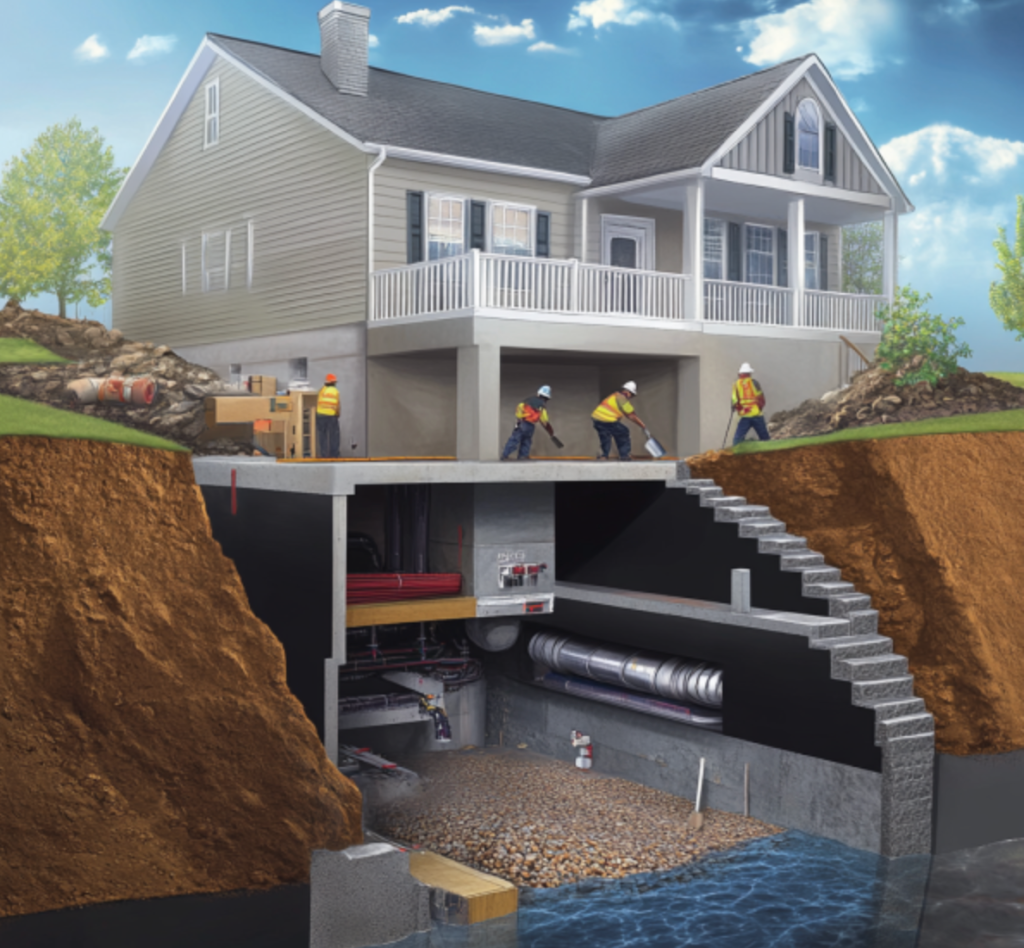The Waterproofing Science: How Different Materials and Techniques Work
We’ve all heard the horror stories – damp smells, mold creeping up the walls, and belongings floating in a pool of murky water. Whether it’s a historic home or newly built property, water infiltration can turn any cozy basement into a nightmare. What, then, is the secret to having a dry, functional, and inviting below-the-ground space? It’s all in the science of waterproofing a basement. Understand the different materials and techniques, and you are halfway through preventing water infiltration from making your basement a swamp instead of a sanctuary. Let’s dive deep into this fascinating world of waterproofing and see how it works.

Why Is Basement Waterproofing Important?
Before we head into the nitty-gritty details about the different materials and techniques used to waterproof a basement, let’s understand why this is such an integral part. The basement is typically the most vulnerable part of your house to water damage. Being below the ground, basements are more susceptible to moisture from the soil, heavy rain, and even seepage from ground water. If left untreated, moisture will lead to structural damage, mold growth, and an array of other problems that can degrade the integrity of your house and your health.
The Science Behind Waterproofing: How Does It Work?
Waterproofing is all about creating a series of barriers that block water from reaching certain areas where they are not wanted. To understand how this is achieved, we have to consider the various materials and methods of waterproofing and their action in keeping water out.
- Exterior Waterproofing: The First Line of Defense
Exterior waterproofing is the process of creating a barrier outside of your basement walls, stopping water from entering. In fact, this is considered one of the most effective ways because it tries to fight the problem of water from the very root end.- How It Works: Generally, an exterior waterproofing consists of excavating the soil around the basement walls and then applying some waterproof coating or membrane. Thus, a shield is created which resists the entrance of water into the walls.
- Materials Used:
- Bituminous Membranes: These are composed of a mixture between asphalt and rubber compounds. They provide a flexible and durable water barrier. Bituminous membranes have been extensively used in major basement waterproofing projects in view of their high efficiency and relatively low cost.
- Polyurethane Membranes: The liquid-applied membranes cure to form a seamless elastic waterproof layer. Polyurethane is very resistant to water and weather conditions; it is therefore ideal for areas where the temperatures fluctuate a lot.
- Cementitious Coatings: A cement-based waterproofing compound is applied to the exterior walls for a hard, water-resistant surface. Cementitious coatings are in most cases combined with other applications for added protection.
- Interior Waterproofing: Managing Water from the Inside
Interior waterproofing is the method of controlling water that has already penetrated the walls or floor of the basement. It’s a popular option because it’s less invasive compared to exterior methods, and it can be employed in managing water entering the home through leaks or cracks.- How It Works: In a general sense, interior waterproofing refers to coating, sealants, or a drainage system on the interior walls and floors to block or divert water away from the basement.
- Materials Used:
- Epoxy and Urethane Sealants: They are injected into the cracks and crevices in the basement walls or floor. The sealants bond with concrete and expand in order to fill out gaps through which water might seep.
- Acrylic Coatings: Generally, acrylic-based coatings are applied to interior surfaces for the creation of an impervious barrier. In most applications, they work together with other methods like the sump pumps in effectively managing water infiltration.
- Interior Drainage Systems: This includes the collection of water through channels and pipes into a sump pump. The sump pump evacuates this water from the basement outside the house. Interior drainage systems work effectively in regulating water entering through the floor or walls.
- Drainage Systems: Keeping Water Away
No waterproofing method is complete without incorporating drainage systems. They are designed in such a way that the water moves away from the foundation of your home, lest accumulation and leakage to the basement occur.- How It Works: Generally speaking, there are two types of drainage systems: exterior and interior. Exterior drainage systems, such as French drains, are set up around the exterior perimeter of the house to divert water away from the foundation. Interior drainage systems collect water that has entered the basement and pump it outside.
- Materials Used:
- Perforated Pipes: Around the foundation, perforated pipes are meant for the collection of water and re-routing. They are usually wrapped around gravel to provide an easy flow of water, while the soil and other debris will not be able to clog the system.
- Sump Pumps: A sump pump is placed in a sump pit, from which water is collected and then pumped away from the house. In areas where the water table is high or where flooding occurs frequently, sump pumps are very important in homes.
- Vapor Barriers: Protection from Moisture
Although waterproofing creates barriers against the intrusion of water, controls of moisture are an important consideration, too. Among its primary functions, a vapor barrier can prevent the passage of moisture through walls and floors to avoid mold and mildew.- How It Works: Generally, vapor barriers are installed on the interior walls or floors of the basement. These create a seal that prevents moisture from condensing on surfaces, keeping the basement dry and mold-free.
- Materials Used:
- Polyethylene Sheets: These are robust sheets of plastic that act to inhibit moisture. Very often, polyethylene sheets are applied with other techniques to form a fully rounded leak protection.
- Foam Board Insulation: In the foam board insulation method, there is a layer of material that resists moisture and could be attached to the basement area walls to help in avoiding moisture accumulation and reduce energy loss.
Choosing the Right Waterproofing Solution for Your Basement
The best method of waterproofing one’s basement depends upon a number of factors, including age and condition of one’s home, climate, and personal budget. A combination of several techniques, materials often proves most effective in protection against water damage.
- Assess Your Needs
Consider the specific problems that your basement issues. Is it susceptible to heavy flooding, condensation, or a leak here and there? Knowing how and how often you have water problems will help you find the best solution for your basement. - Combine Methods for Maximum Protection
Don’t rely on just one method! The integration of interior and exterior waterproofing, drainage systems, and vapor barriers provides the complete protection a basement needs. A typical example could be exterior waterproofing combined with a French drain and sump pump, which will be doubly effective in preventing infiltration and accumulation of water. - Maintenance is the Key
Even the best waterproofing systems require periodic maintenance to keep them functioning. Periodically inspect for cracks and leaks and evidence of moisture; make sure drainage systems and sump pumps work correctly, and immediately repair whatever damage it may have taken to avoid costly water damage.
Final Thoughts: Understand the Science of Waterproofing
Basement waterproofing is more than a simple slapping on a coat of sealant. It is a science, which calls for an understanding of water and moisture behavior, choosing the appropriate materials, and applying the right techniques to keep your basement dry and safe. By mastering these elements, you will be able to shield your home from water infiltration damage, extend comfort in your living space, and further add value to your property.
So, if you are ready to make that basement of yours into a dry, cozy retreat, prepare yourself first with the right knowledge and tools. After all, this is where the understanding of the science behind waterproofing should start for there to be such a thing as one day having an utterly worry-free, completely water-free home.
Read Also: The Best Ways to Use a Water Flosser





